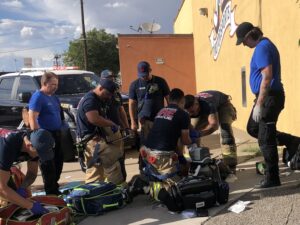At the beginning of November, more than twice as many Missouri school districts were conducting all classes in-person as were providing education remotely because of the coronavirus pandemic.
Because the in-person districts were generally smaller than those in virtual education, the number of students learning online was about 50 percent higher than the number in districts with only in-seat classes.
As November ends, the situation has flipped.
There are more districts with virtual learning — 151 — than providing on-site instruction. And the number of students attending classes online — 316,116 — is more than four times the number enrolled in districts with in-seat classes.
That was one impact of the worst month yet for new COVID-19 infections in Missouri, with 116,576 new cases reported by the Department of Health and Senior Service, more than double the 57,073 reported in October. The first day with more than 3,000 new cases was Oct. 29 and only five days in November recorded fewer than 3,000 cases.
The health agency recorded 39 percent of the total 299,762 COVID-19 cases during November.
The state reported 806 deaths in November, about 100 fewer than reported in October but both months’ totals include several large adjustments as the health department reviewed past death reports to identify cases that had not been included in daily reports.
There have been 3,829 deaths since the first was reported in mid-March.
During November, the per-capita infection rate statewide was 1,861 per 100,000 people. Of the 117 local heath jurisdictions tracked in by the state health agency, 62 had infection rates above the state average, with the highest, Cole County, more than double that rate at 3,840 per 100,000 people.
Of the 20 counties with the highest infection rate, most are rural. Only three have a population of 50,000 or more. Along with Cole, the local jurisdictions counties with the highest infection rates, are Perry, Gentry, Moniteau and Ste. Genevieve counties.
The situation in Missouri hospitals, already dire at the end of October, continued to deteriorate during November. When the month began, there were 1,632 people being treated as inpatients, 226 were on ventilators and the Missouri Hospital Association was reporting that 32.3 percent of intensive care beds were available. As of Friday, there were 339 COVID-19 patients on ventilators, with only 21.3 percent of all ICU beds and 17.2 percent of adult ICU beds available as of Thursday.
In other evidence of an overwhelmed health system, many health departments around the state are giving up on contact tracing, telling residents to inform their friends, family and coworkers that they have COVID-19. Without a statewide mask order, more and more local governments are issuing local mask orders, most with penalties that include fines for individuals and businesses that don’t comply.
The Missouri Senate is scheduled to meet this week to complete work on a $1.3 billion spending bill that mainly adds new spending authority for federal CARES Act funding received in April. The bill also includes $18.7 million in new funding for grants to local agencies to prevent homelessness and $96 million so the state can distribute child support payments to custodial parents.
Our stories may be republished online or in print under Creative Commons license CC BY-NC-ND 4.0. We ask that you edit only for style or to shorten, provide proper attribution and link to our website. AP and Getty images may not be republished. Please see our republishing guidelines for use of any other photos and graphics.





